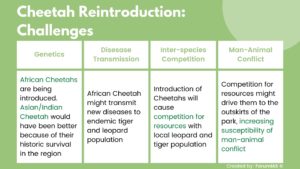ForumIAS announcing GS Foundation Program for UPSC CSE 2025-26 from 19 April. Click Here for more information.
ForumIAS Answer Writing Focus Group (AWFG) for Mains 2024 commencing from 24th June 2024. The Entrance Test for the program will be held on 28th April 2024 at 9 AM. To know more about the program visit: https://forumias.com/blog/awfg2024
Contents
- 1 Introduction
- 2 Key details about Cheetahs
- 3 What has been the history of Cheetahs in India?
- 4 How did the cheetah become extinct in India?
- 5 What is the action plan for cheetah reintroduction in India?
- 6 Why are the expected benefits of cheetah reintroduction?
- 7 What are the challenges associated with cheetah reintroduction?
- 8 What should be the approach?
- 9 Conclusion
| For 7PM Editorial Archives click HERE → |
Introduction
The Supreme Court had approved the Cheetah Reintroduction in India in January 2020. Since then the wildlife enthusiasts have been ardently waiting to see cheetahs in the wild in India. The COVID-19 pandemic had delayed the process especially due to the emergence of the Omicron variant in South Africa from where some cheetahs were to be translocated. However the situation is now improving and the process has again gained some pace. A delegation from India had visited Namibia in February 2022 to discuss the translocation logistics with the Namibia Government. Namibia would be giving 3 cheetahs for translocation to India and may become the first nation from where cheetahs would be relocated to Kuno wildlife sanctuary in Madhya Pradesh.
Key details about Cheetahs
The cheetah, Acinonyx jubatus, is one of the oldest of the big cat species. It is also the world’s fastest land mammal and capable of running at speeds of 80 to 128 km/h. They are considered native to Africa and central Iran.
The cheetah occurs in a variety of habitats such as the Savannah grasslands in the Serengeti (Kenya-Tanzania, Africa), arid mountain ranges in the Sahara and hilly desert terrain in Iran. The cheetah is threatened by several factors such as habitat loss, conflict with humans, poaching and high susceptibility to diseases. In 2016, the global cheetah population was estimated at around 7,100 individuals in the wild; it is listed as Vulnerable on the IUCN Red List.
Historically ranging throughout most of Sub-Saharan Africa and extending eastward into the Middle East and to central India, the cheetah is now distributed mainly in small, fragmented populations in central Iran and southern, eastern and northwestern Africa.
The Asiatic cheetah is classified as a critically endangered species by the IUCN Red List, and is believed to survive only in Iran. It is smaller and paler than an African cheetah and looks more like a cat with a smaller head and longer neck.
| Read More: Cheetah (Acinonyx jubatus) |
What has been the history of Cheetahs in India?
India has a long history of cheetahs. The name ‘cheetah’ comes from the Sanskrit word chitraka that means ‘spotted’.
The earliest historical references of cheetahs are in classical Greek records of India from the geographer Strabo, about 200 BCE.
Coming down to the Mughal Period, the cheetahs were used extensively for hunting. Mughal Emperor Akbar had 1,000 cheetahs in his menagerie. People in Central India, particularly Gwalior State and Jaipur State, used to hunt with cheetahs. The last three cheetahs living in the country were killed in 1947 by the ruler of erstwhile Koriya state in present day Chhattisgarh. The species was officially declared extinct in India in 1952.
How did the cheetah become extinct in India?
The animal is extremely easy to tame, compared to other non-domesticated predators, and was used to hunt prey, a sport called ‘coursing’. The animal was a popular part of many royal courts throughout India and other parts of Asia where it was found.
But another trait of the cheetah was that it was impossible to breed in captivity. There was only one recorded successful attempt of breeding a cheetah in captivity until the 20th century, an event recorded by Emperor Jahangir in 1613 in the book Tuzuk-i-Jahangiri.
As the Cheetah’s number dwindled due to the high number of Cheetahs being taken from the wild, the animal was also then finally brought to extinction with the advent of the widespread hunting brought to India during the time of the British Raj.
While the government has officially stated that the animal was driven extinct from desertification, experts suggest that the animal had plenty of habitat and prey population to survive if it weren’t hunted to extinction.
What is the action plan for cheetah reintroduction in India?
Under the action plan, the Government of India would bring 50 Cheetahs over the next five years to form a founding population of the species. Further, former cheetah-range states, i.e. Gujarat, Rajasthan, Chhattisgarh and Madhya Pradesh would be duly analyzed by the experts.
As part of the plan, India will be translocating around 12-14 cheetahs from South Africa, Namibia and Botswana to Kuno Palpur National Park in Madhya Pradesh. Kuno National Park has been chosen because of its suitable habitat and adequate prey base. KNP is 748 sq. km. in area, devoid of human settlements and is estimated to have a capacity to sustain 21 cheetahs.
Each of these cheetahs would also be fitted with Satellite/GSM-GPS-VHF radio-collars before their release in the wild so as to enable monitoring remotely. This could be the world’s first intercontinental cheetah translocation project.
Why are the expected benefits of cheetah reintroduction?
Suitable Living conditions: The cheetah used to live and thrive in the Indian Subcontinent for centuries, hence their reintroduction is a realistic step. Further, the proposed location of Kuno is a woodland and cheetahs have been known to survive in woodland. Cheetahs are quite good at navigating the whistling thorn and acacia scrublands in places like the Maasai Mara game reserve in Kenya (contiguous to Serengeti National Park in Tanzania)
Sufficient Prey: The Kuno national park has a good prey base for cheetahs, comprising the four-horned antelope, chinkara, nilgai, wild pig, spotted deer and sambar.
Ecosystem stability: In saving cheetahs, one would have to save not only its prey-base comprising certain threatened species, but also other endangered species of the grasslands and open forest ecosystems.
Less probability of Man-Animal Conflict: It is also observed that among large carnivores, conflict with human interests is lowest for Cheetahs. They are not a threat to humans and do not easily attack large livestocks.
Economic Relevance: Reintroduction of a flagship species like Cheetah would attract a significant amount of tourism to the cheetah range states. This would give a boost to other sectors like transportation, hotels etc. and also generate additional jobs.
What are the challenges associated with cheetah reintroduction?
Genetic Differences: Many experts have expressed concerns over reintroduction of African Cheetahs instead of Asiactic cheetahs. They believe that Asiactic cheetahs would have been a more suitable choice considering historical survival of species in the region and their ability to quickly acclimatize.
Disease Transmission to other species: There are very few diseases unique and specific to predators. However, transmission of these to the endemic tiger population is a cause for concern.
Inter Species Competition: The Kuno National Park is already home to around 30 leopards. Tigers from the Ranthambore Tiger Reserve in Rajasthan, 140 km away from Kuno, are also believed to migrate to the park. The proximity of three predators in the same ecosystem may reduce survival rates of cheetahs.
Man Animal Conflict: More aggressive predators such as tigers and leopards will compete with the cheetahs in the park. They may drive cheetahs to the outskirts of the park, where it could come into conflict with humans.
What should be the approach?
First, active negotiations should be done with the Convention on International Trade in Endangered Species of Wild Flora and Fauna (CITES), as its permission is necessary for initiating translocation.
Second, a detailed analysis on animals’ lineage and condition should be checked in the host country. This would ensure that they are not from an excessively inbred stock and are in the ideal age group, so as to conform to the needs of a founding population.
Third, the wildlife authorities should be prepared for some attrition arising out of natural interactions e.g., around 10% cheetahs in Savannah in Africa are killed by lions. A similar ratio may be killed by Tigers in Kuno. The officials must expect some deaths and tolerate the negative and damaging interactions with cheetahs, keeping in mind the long term goal of creating a natural interactive landscape and habitat.
Fourth, the strategy of cold release should be duly followed as suggested by experts. Under this, the cheetahs would be kept in an enclosure called a boma and prey will be released into this enclosure for cheetahs to catch.
Conclusion
A careful analysis of pros and cons shows that cheetah reintroduction is feasible in India considering the species used to exist in the region for centuries. However, the associated concerns should be duly addressed to ensure their long term survivability.
Summary in Graphics
Source: Down to Earth, PIB, Economic Times









